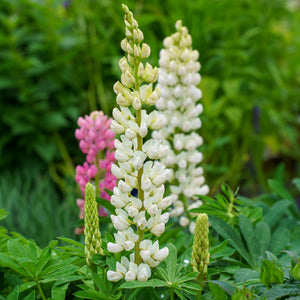The Lupinus Guide
Lupinus, commonly known as lupine, brings a touch of vibrant color and vertical interest to any garden landscape. Known for their tall spires of pea-like flowers and attractive foliage, Lupinus plants are perfect for adding height, texture, and a striking display to borders, garden beds, and cottage gardens. These plants are admired for their ability to thrive in a range of soil conditions and their relatively easy care. Whether you're aiming to enhance your garden's visual appeal, create a stunning floral display, or add a unique element to your space, Lupinus offers a captivating and versatile solution. Explore our Lupinus Guide to learn more about cultivating and caring for these beautiful plants, and discover how to incorporate them into your garden for lasting beauty and enjoyment.
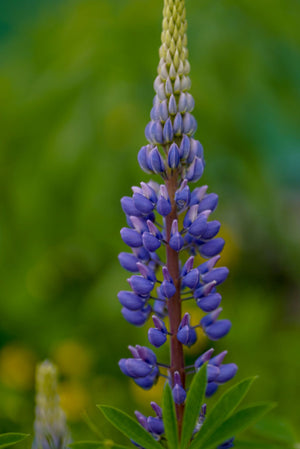
About Lupinus
Lupinus is a large genus of flowering plants in the Fabaceae family, comprising about 200-600 species. These plants are native to a variety of regions, including North and South America, the Mediterranean, and parts of Africa. The name "Lupinus" is derived from the Latin word "lupus," meaning wolf, possibly due to a mistaken belief that these plants robbed the soil of nutrients. In fact, Lupinus plants are legumes, meaning they enrich the soil by fixing nitrogen.
Lupinus plants are known for their dense, upright flower spikes that come in a wide range of colors, including purple, blue, pink, yellow, red, and white. The flowers are typically arranged in tall, conical spikes and bloom in late spring to early summer. The foliage consists of palmate leaves with leaflets arranged like the fingers of a hand, adding a unique texture to the garden. Lupinus can be perennial or annual, depending on the species, and they thrive in cooler climates.
Some popular species and varieties of Lupinus include Lupinus polyphyllus (Bigleaf Lupine), known for its tall flower spikes and wide color range, Lupinus perennis (Wild Lupine), a native species with blue or purple flowers, and Lupinus 'Russell Hybrids,' a popular hybrid series with vibrant flowers and robust growth. Each species and variety has its unique characteristics, but all share the common traits of tall flower spikes and nitrogen-fixing properties.
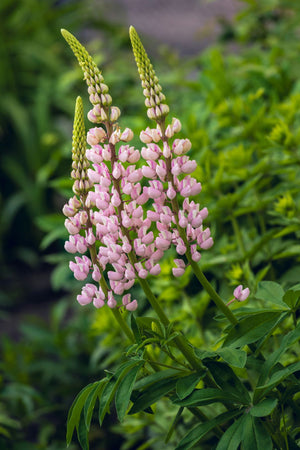
Planting Lupinus
Lupinus plants require specific planting conditions to ensure their successful establishment and flourishing growth. Here are some essential guidelines for planting and caring for Lupinus:
Soil: Lupinus prefers well-draining, slightly acidic to neutral soil. A sandy or loamy soil works best. Ensure the planting site is free from heavy clay or waterlogged conditions, which can cause root rot. Lupines thrive in poor to moderately fertile soils and do not require heavy fertilization.
Light: Lupinus thrives in full sun to partial shade. Choose a location with at least six hours of direct sunlight per day for optimal blooming. In hotter climates, some afternoon shade can help protect the plants from intense heat.
Watering: Lupinus is relatively drought-tolerant once established but requires regular watering during the initial growth period. Water the plants deeply, allowing the top inch of soil to dry out between waterings. During hot, dry periods, increase the frequency of watering to maintain soil moisture.
Planting Depth: Plant Lupinus seeds or transplants at the appropriate depth, as indicated on the seed packet or plant label. Space the plants 12-24 inches apart to allow for proper air circulation and growth. When planting in the ground, dig a hole twice as wide and the same depth as the root ball to encourage root spread.
Mulching: Apply a layer of organic mulch, such as compost or shredded leaves, around the base of the plants to retain moisture, suppress weeds, and regulate soil temperature. Avoid covering the crowns directly, as this can lead to rot.
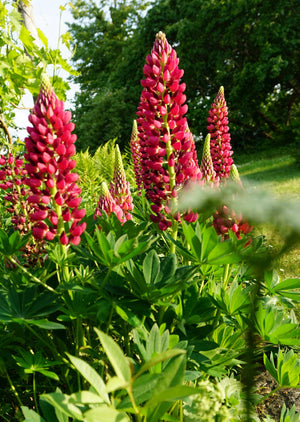
Care for Lupinus
Lupinus plants require specific care to ensure their optimal growth and health. Here are some general guidelines for the care of Lupinus:
Watering: Keep the soil consistently moist during the growing season but avoid waterlogging. Water the plants deeply, allowing the top inch of soil to dry out between waterings. During hot, dry periods, increase the frequency of watering to maintain soil moisture. Once established, Lupinus is quite drought-tolerant.
Fertilizing: Lupinus does not require heavy fertilization. As legumes, they fix nitrogen in the soil, reducing the need for additional fertilizers. A light application of a balanced, slow-release fertilizer in early spring may be beneficial, but avoid over-fertilizing, as this can lead to excessive foliage growth at the expense of flowers.
Pruning: Remove spent flower spikes to encourage continuous blooming and trim back any damaged or dead foliage as needed. At the end of the growing season, cut back the plants to the ground to prepare for winter. Pruning is best done in late fall or early spring.
Pests and Diseases: Lupinus is relatively pest-resistant but can be susceptible to issues such as aphids, slugs, and powdery mildew. Inspect your plants regularly and treat any infestations promptly with appropriate organic or chemical controls. Maintain proper spacing and air circulation to reduce the risk of diseases.
Winter Care: In colder climates, Lupinus plants are hardy and can withstand winter temperatures. Apply a layer of mulch around the base of the plants to insulate the roots and protect them from freeze-thaw cycles. Remove the mulch in early spring to allow new growth to emerge.
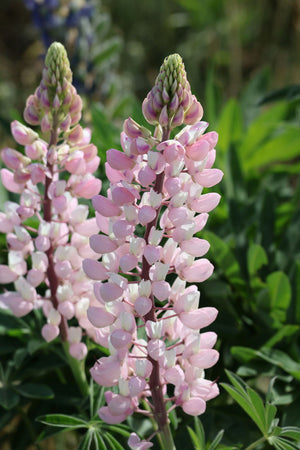
How to Use Lupinus
Lupinus offers versatility and can be utilized in various ways to enhance your garden and outdoor spaces. Here are some recommendations based on their characteristics:
Borders and Beds: Lupinus’s tall flower spikes and vibrant colors make them perfect for adding height and drama to garden borders and flower beds. Plant them in clusters or drifts for a dramatic display of color and form.
Cottage Gardens: Lupinus is a classic choice for cottage gardens, where its old-fashioned charm and colorful blooms can be showcased. Combine them with other cottage garden favorites like roses, delphiniums, and foxgloves.
Pollinator Gardens: Lupinus flowers attract pollinators such as bees and butterflies, making them a valuable addition to pollinator gardens. Plant them alongside other pollinator-friendly plants to create a thriving ecosystem that supports local wildlife.
Mass Plantings: In larger landscapes, Lupinus can be used in mass plantings to create a stunning visual impact. Their tall stems and bright flowers can fill large spaces with color and texture.
Mixed Plantings: Combine Lupinus with other sun-loving perennials, such as coneflowers, rudbeckia, and salvia, to create a lush, colorful garden. Their tall flower spikes and vibrant colors will complement other plants beautifully.
Conclusion
Lupinus is a captivating and versatile addition to any garden or outdoor space. With their tall flower spikes, vibrant colors, and relatively easy care, Lupinus plants bring a touch of dramatic elegance and cheerful brightness to your environment. Their adaptability to various growing conditions and ease of care make them a favorite among gardeners of all levels. By following proper planting and maintenance techniques, you can fully harness the potential of Lupinus to enhance your garden, creating a lasting impact.
Whether you seek to create stunning flower displays, add visual interest to borders and beds, or enjoy their beauty in cottage gardens, Lupinus can fulfill a variety of roles in your landscape design. Place them individually to highlight their unique blooms and tall stems, or combine different species and varieties for a dynamic and visually appealing display. Lupinus’s resilience and adaptability also make them ideal for mass plantings and pollinator gardens.
Beyond their ornamental value, Lupinus plants contribute to the overall beauty and charm of your garden ecosystem. With their enduring beauty, versatility, and ecological significance, Lupinus plants bring delight and natural allure to your outdoor environment, enriching your gardening experience and enhancing the overall beauty of your landscape.



